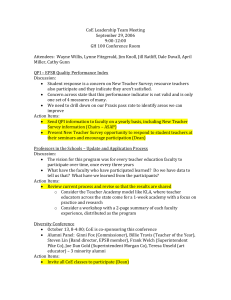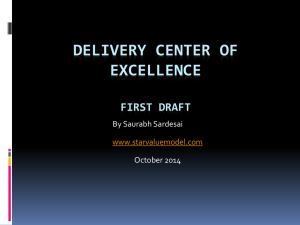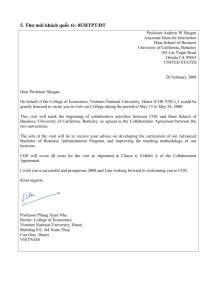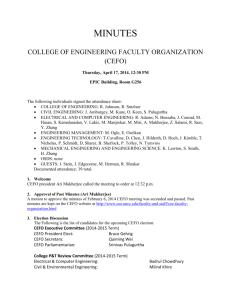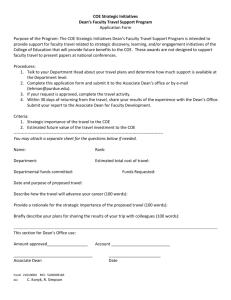Recommendation 1 of October 9, 2006
advertisement
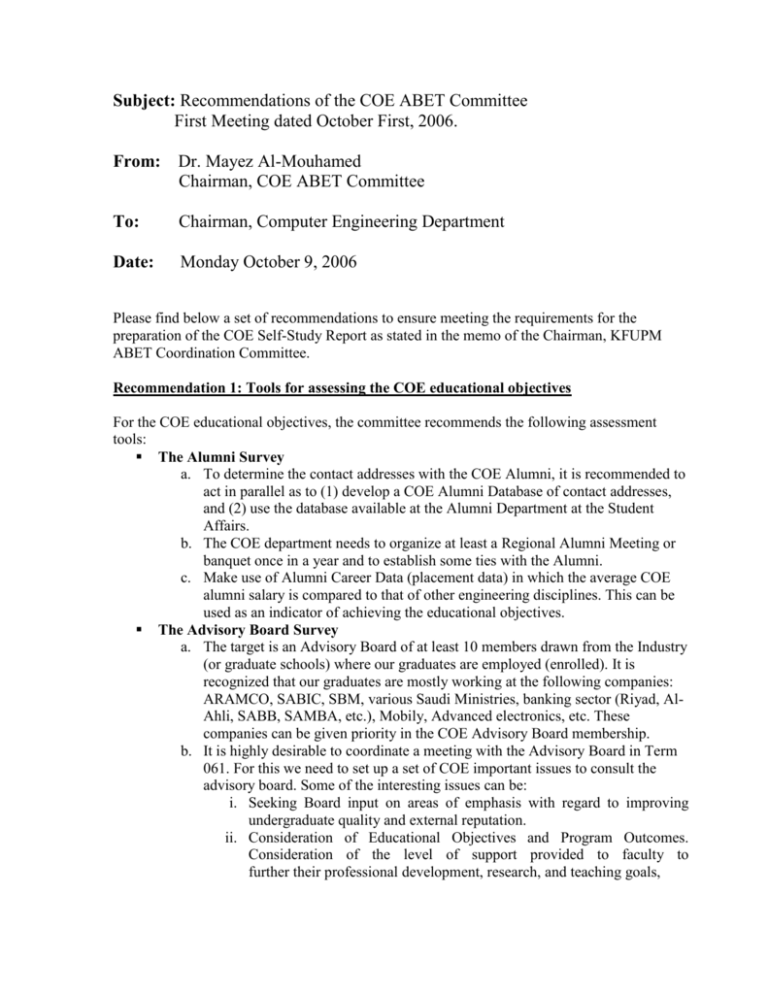
Subject: Recommendations of the COE ABET Committee First Meeting dated October First, 2006. From: Dr. Mayez Al-Mouhamed Chairman, COE ABET Committee To: Chairman, Computer Engineering Department Date: Monday October 9, 2006 Please find below a set of recommendations to ensure meeting the requirements for the preparation of the COE Self-Study Report as stated in the memo of the Chairman, KFUPM ABET Coordination Committee. Recommendation 1: Tools for assessing the COE educational objectives For the COE educational objectives, the committee recommends the following assessment tools: The Alumni Survey a. To determine the contact addresses with the COE Alumni, it is recommended to act in parallel as to (1) develop a COE Alumni Database of contact addresses, and (2) use the database available at the Alumni Department at the Student Affairs. b. The COE department needs to organize at least a Regional Alumni Meeting or banquet once in a year and to establish some ties with the Alumni. c. Make use of Alumni Career Data (placement data) in which the average COE alumni salary is compared to that of other engineering disciplines. This can be used as an indicator of achieving the educational objectives. The Advisory Board Survey a. The target is an Advisory Board of at least 10 members drawn from the Industry (or graduate schools) where our graduates are employed (enrolled). It is recognized that our graduates are mostly working at the following companies: ARAMCO, SABIC, SBM, various Saudi Ministries, banking sector (Riyad, AlAhli, SABB, SAMBA, etc.), Mobily, Advanced electronics, etc. These companies can be given priority in the COE Advisory Board membership. b. It is highly desirable to coordinate a meeting with the Advisory Board in Term 061. For this we need to set up a set of COE important issues to consult the advisory board. Some of the interesting issues can be: i. Seeking Board input on areas of emphasis with regard to improving undergraduate quality and external reputation. ii. Consideration of Educational Objectives and Program Outcomes. Consideration of the level of support provided to faculty to further their professional development, research, and teaching goals, iii. Review of department area of concentrations, and enhancing undergraduate education in some specialized areas. iv. Survey the board members regarding their views on the importance of each aspect of the departmental Educational Objectives. Employer Survey To determine the potential employer of the COE graduates it is suggested to coordinate a visit to ARAMCO higher-management. This will facilitate the direct contacts with ARAMCO department directors and managers which are supposed to have COE graduate in their departments. Recommendation 2: Tools for assessing the COE educational outcomes For the COE educational outcomes, the committee recommends the following assessment tools: Course Assessment. The faculty carries out course assessment by describing how their students are performing with respect to a set of recognized course outcomes. It is recommended that the course assessment be based on a common stream of COE courses which are: COE 202-203, 205,305,308, 342,360, 390, 399, 442, and 400. It is recommended that the COE describes both options (1) No Co-Op, and (2) with Co-Op and shows that the students taking either of these options meet the minimum requirements towards the educational outcomes. In this view we may refer to the employer survey from the Co-Op as well as the faculty Survey for the COE 485 to enforce the outcome achievements for either of the above options. Exit Exam and Survey An exit exam covering the three COE areas: (1) networking, (2) architecture, and (3) digital design is sufficient. In each area, we may have three questions (gradual levels) on the basics, the skills, and applications. Each question can be just 5 minutes so that the overall exit exam will take 45 minutes. The exit Exam and Exit Survey can be enforced by different means: (1) as an internal requirement in COE 400, i.e. a course that is taken by all COE students, and (2) exit exam is to be taken just before graduation. We may indicate on the student transcript that the student took an Exit Exam and the score he obtained. Student Portfolios This requirement needs to be done by all COE students and collected student portfolios be archived at the department for consultation by the ABET team upon their visit to KFUPM in 2007-2008. This requirement can be instituted as a Zero-Credit Course that accumulates in one folder the student’s description of his design achievements and performance in a sub-set of COE courses of his choice. The objective is to show the student improvement from one experience to the other and to state at the end whether the student achieved some acceptable level or not. Recommendation 3: Survey engine and survey server group The accreditation process at the COE department requires the use of a "Survey Engine" installed on a “Survey Server” to accomplish the following tasks: (1) COE faculty may automatically generate assessment surveys (course, student, faculty, alumni, advisory board, employer, etc. (2) Surveys can be made accessible through the web by installing on a “Survey Server” located at the COE (3) Collected survey data is to be saved in a common database at the “Survey Server” (4) Ability to generate statistics for a single survey (5) Content management: each survey uses a collection of attributes that receive some votes. Assessment of department outcomes requires setting up queries that carry out statistical analysis over a subset of surveys for a given common attribute, For example a specific attribute like “Engineering Aspects” that is used in different surveys. (6) Ability to generate statistical graphs such as mean and distribution over a cluster of categories. o Group responsibility: Coordinator: Mr. Bambang Sarif Member: Mr. Ya'u Garba o Group tasks: coordinate with Chairman of ABET Committee and its subcommittee chairmen in the selection of a Survey Engine, carry out benchmarking of survey engines to meet above specifications, ordering, acquisition, installing on a local server, assist the faculty in the design of web surveys, survey testing and reporting, web survey activation, maintenance of database for survey data, assist faculty in querying the database to collect statistical data as needed by the ABET Assessment Committee. Recommendation 4: Faculty assignments for the preparation of the Self-Study Report We refer to the preparation of the Self-Study Report (SSR) and the Guidelines provided by the University for the writing of SSR. Each section of the SSR is assigned to a team of faculty. In the assignment of duties, a section of SSR is assigned to the departmental committee (s) that is the most relevant to the needed background. A section is assigned to a team of faculty when there is no departmental committee dealing directly with the section issues. In this case the experience of individual faculty is taken into consideration. The action plan for each assignment is taken from the KFUPM Guidelines for Preparation of the SSR. Some helpful comments are added by the COE ABET Committee in Bold Italic to help providing more information about the action plan. The editorial work refers to the writing of the SSR section without providing the survey data (if any). The survey data refers to the data collected from the corresponding set of surveys (see recommendation 1 and 2 of this memo) that fall into the section assignment. Samples of SSR are available from URL: http://www.ccse.kfupm.edu.sa/~mayez/ABET-Self-Study-Reports.zip Please contact Dr. M. Al-Mouhamed (2934) for any additional information. The committee recommends the following Section-Assignment of the Self-Study Report: The Background o Responsibility: Coordinator: Dr. Yamani Members: Drs Baroudi and Raad o Action Plan: - It contains four sequential sections o A.1 Degree Title ………….(e.g. Engineering) Bachelors degree in Civil o A.2 Program Modes (Day program) o A.3 Actions to correct previous shortcomings - check with the department and the college dean regarding the comments made by ABET at the last visit. - Itemized actions taken by the department in response to the comments. o A.4Contact information Prof. Samir Al-Baiyat Dean, College of Engineering Sciences King Fahd University of Petroleum & Minerals KFUPM Box 5056 Tel: +966-3-860 2500 e-mail: sbaiyat@kfupm.edu.sa COE ABET Committee hints: Describe the curriculum strategy (Breadth within COE discipline), flexibility (electives), connection to ABET and IEEE/ACM BOK. Previous ABET visit was in (1997-1998 check again!). It generated the following comments: (1) well designed COE curriculum from a technical perspective which is comparable to better USA programs, (2) tight program, need to create more flexibility (electives), (3) good lab organization but can improve if experiments and manual are periodically updated. Previous Self-Assessment Team in 2004 (one external member (from USA) and two KFUPM members) generated some useful feedback. The most important comment was the need for COE department to prepare for ABET EC 2000 Criteria as soon as possible by properly revising its course/lab delivery and setting up a quantitative assessment system that shows evidence of regular curricular corrections. o Editorial work delivery deadline: Wednesday, November 29, 2006 The Students (Criterion 1) o Responsibility: Coordinator: Dr. Al-Kharobi Members: Drs Amin, and Naseer o Action Plan: - Describe how students are evaluated, advised and monitored in a manner consistent with program objectives, as required by Criterion I. Address each item individually. - Describe the processes and procedures used to enforce policies for the acceptance of transfer students and provide evidence that the processes and procedures are working. - Describe the procedures used to validate credit for courses taken elsewhere and provide evidence that the procedures are working. o Editorial work delivery deadline: Wednesday, November 29, 2006 Program Educational Objectives (Criterion 2) o Responsibility: Coordinator: Dr. Amin Members: Drs. Alrabaa, Yamani, Al-Kharoubi, Sqalli, Bouhraoua, AlNajjar, Sait, and Mr Shazli o Action Plan: - List the program educational objectives and show how they are consistent with the mission of the institution and the accreditation criteria. - Identify the significant constituencies of the program. - Describe the processes used to establish and review the program educational objectives and the extent to which the program’s various constituencies are involved in these processes. Provide documentation that demonstrates that the processes are working. - Describe how the program curriculum and your processes ensure achievement of the program educational objectives. - Provide documentation that describes the ongoing evaluation of the level of achievement of these objectives, the results obtained by this periodic evaluation and evidence that the results are being used to improve the effectiveness of the program. COE ABET Committee hints: Editorial Component: Set up a paragraph (sentence) on the department educational objectives, breakdown (informally) the above paragraph into itemized objectives, show how to relate the objectives to college and departmental missions and to educational objectives (See Sample SSR), relate the objectives to the curricular elements, determine what are the program constituencies (prospective students, Alumni, Advisory Board, Faculty, students, Corporations, some graduate schools, etc.), describe the departmental relationships (meeting frequency and discussed topics) with some selected program constituents, and describe the mechanisms in the COE department that assures consideration of the feedback on the objectives and implied curriculum revision. Survey Data Component: Set up teams of two faculty for establishing database of contacts with (1) the Alumni, (2) Advisory Board members, and (3) the COE Graduate Employers. Coordinate a meeting in T061 for the Advisory Board with well defined departmental program before the end of semester, establish some ties with the Alumni such as making an Alumni Day (get-together), coordinate Faculty visits to some employers describing our accreditation process to improve our program and the need for feedback on our graduate (if any). Consult the advisory board on the departmental objectives, outcomes, and strategic plan (do we have any!). Review the departmental survey forms (Alumni, Advisory Board, and Employer). Arrange for filling the surveys and collect the data. Ideally we need a web-based survey engine (will be provided) and some automated tools to generate statistics and distribution for each surveyed question. Discuss the surveyed data and provide a short report on how to revise the program to better meet the concerns raised by the above constituencies. Incorporate the survey data and detailed analysis of the data and implied curricular decisions in your section. Provide a detailed analysis on the success of COE graduate. For example many COE graduates are very successful in their professional career both at the industry level and the international graduate schools. At the industry level, COE graduates occupy executive and managerial position at ARAMCO, KACST, Banking sector, and many governmental agencies such as the Saudi National Information Center at the Ministry of Interior and other ministries. COE graduates are also very successful at international graduate schools such as Stanford University, University of Texas A&M, etc. About 20% of COE faculty are COE graduates who joined the COE department after completing their PhD in the US or Canada. o Editorial work delivery deadline: Wednesday, November 29, 2006 o Survey data delivery deadline: Tuesday, January 30, 2007 Program Outcomes (Criterion 3) o Responsibility: Coordinator: Dr. El-Maleh Members: Drs Baroudi, Mudawar, Sheltami, Mahmoud, Abu-Amara and Mr. Selmi o Action Plan: - List the program outcomes that have been established based on the program educational objectives and describe how these program outcomes relate to the program educational objectives. When referring to program outcomes, use outcomes (a) to (k) as shown in Criterion 3. - Describe how the program outcomes chosen by the program encompass and relate to the outcome requirements of criterion 3. - Describe the processes used to produce and assess each of the program outcomes. - Provide metric goals for each outcome that illustrate the level of quality of outcomes achievement felt necessary to produce graduates that will ultimately achieve the educational objectives following their graduation. COE ABET Committee hints: Editorial Component: Set up the department Educational Outcomes, use the condensed A-K with some specific outcomes, show how to relate the outcomes to the college and departmental missions and to the educational objectives (See Sample SSRs). Provide a flow-chart showing the outcome assessment process in the department, i.e. going through the cycle: (1) Course assessment, course evaluation, MQP, Exit Exam/Survey, (2) Assessment committee making data analysis and curricular decisions, (3) Decision implementation by the concerned department committees. Describe the assessment process cycle. Describe the metrics used and goals on the assessment data (average score and distribution) to determine the evidence that the graduate achieved the outcomes and the confidence level in their achievement of the program objectives. For course assessment we need to include as a common stream the courses: COE 202-203, 205, 305, 308, 342, 360, 390, 399, 442, and 400. Add the two possible paths COE 485 and COE 351/2. We need to show that students completing either of the above options meet the minimum requirements for the educational outcomes. Please provide a table that maps the above COE courses to the educational outcomes as a common stream taken by all students, a non Co-op option (COE 485), and Co-op option (COE 351/2). It is critical to explain to the faculty that adapting the COE program to ABET EC 2000 means CHANGING our way of course delivery (teaching and Lab) so that the course outcomes will have a better mapping to the educational outcomes, i.e. stronger correlation. A program that has weak correlation with the outcomes is necessarily not conforming to ABET EC 2000 spirit. We need to change our Lecture, Exams, and most importantly the LAB so that we address not only the technical course aspects (attr. a, b, c, and e) but also the attr. on: (1) Effective Team Member (attr. d), (2) oral and written communication (attr. g), and (3) the use of tools (attr. k). For examples, the exams must also be designed to address as directly as possible the course outcomes. Therefore, you are requested to revise the lab organization in COE 200, 305, 400, 442, and COE 485 to put explicit emphasis on the above attributes. Please revise the mapping from the COE courses to the program outcomes to reflect the above changes. A stronger correlation between the COE courses and the outcomes is expected after addressing the needed changes in course/Lab delivery. Here is a guideline for setting up the outcomes for each course: All 200 and 300 level courses may address up to 6 attributes. A typical set is a, b, c, e, i, and k. Attr. i is associated to the student awareness of life-long learning through participation in professional societies (IEEE-chapter, computer club short courses) and graduate schools. All courses having a lab component should address attr. (d) on team-work as far as the students are working in teams. Notice that this attribute must also address the ability to team work in a multi-disciplinary team (see Co-op, summer training, etc.) COE 400 and 485 must be adapted in their delivery to address up to 9 attr.: a, b, c, d, e, g, i, j, and k. Attr. k (use of eng. Tools) must be addressed in courses involving programming or hardware/software integration (COE 205, 305, 400, 485, etc.) Attr. g (communicate effectively) must be addressed in courses involving a lab component or course project with report writing especially for the 300 and 400 levels. Senior Design Project COE 485 and to some extent COE 400 should be evaluated in term of program outcomes, including the extent to which the project demonstrates good engineering design practice and attention to relevant non-technical issues, such as Social, Environmental, and Economic. Specifically, COE 400 and 485 should be revised to address working as part of a team, dealing with adversity, ethics in design, budgeting and planning, time management, ethical aspects in student’s project, oral/written communication, consider nontechnical issues arising in the design project, discuss background of their design and social and political constraints . This way COE 485 and COE 400 will be able to address in their assessment the outcome attributes: a, b, c, d, e, f, g, i, j, and k. Please develop scoring rubric for COE 400 to prepare for a separate assessment (scoring rubric) of all the above attributes so that they can be easily evaluated by the faculty and can be presented in the Self-Study in a separate sub-section due to its importance. Similar procedure can be used for COE 485. For example, other scoring rubrics can address the COE courses (excluding the above). We better provide a local solution for providing in COE 390 sufficient exposure to (1) professional and ethical responsibilities (attr. f), (2) awareness of life-long learning (attr. i), and (3) awareness of contemporary issues (attr. j). Specifically COE 390 must include presentations on: (1) area of concentration in the COE program, (2) role of professional societies (IEEE and ACM) in the engineering profession, (3) speakers from industry to describe the career paths for engineers, (4) speaker from industry or university to present issues on “technical areas of interest to students” like sensor networks, robotics, etc, (5) ethical issues in engineering (the ethics of student survey and course evaluation) such as the video presentation “The Truesteel Affair”, the game “Dilbert Ethics Challenge”, or the ethical-directed story “Dilemma in the Workplace” , (6) outstanding Co-op students to present the role of teams in industrial practice, (7) faculty from CIM to present on the effect of globalization on economics and engineering profession (contemporary issues), (8) a staff from RI to present patenting and intellectual property. As an implementation example we may target a 1-hour presentation on each of these issues and invocation of these issues in some written exam. Also it is highly recommended to include in COE 400 some material on the Impact of Eng. Solution (attr. h). This way we will be able to address attributes h, i, j, and f which will have at least one single course mapping, i.e. an acceptable solution until the University and the new COE program effectively adapt themselves to ABET EC 2000. Survey Data Component: request all the COE faculty to start the process of Course Assessment in their teaching courses, make sure all survey forms are available so that faculty know what they need to fill at the end of the semester (Assessment courses, MQP package). Carry out an information initiative to improve faculty and student (Exit Survey) awareness on the assessment process and surveys and provide technical assistance. Set up a small team to develop the Exit Exam with area coordinators. Please make use of a web survey (Survey Engine will be available) for the processing of course assessment, MQP, and exit survey with the ability to assemble the gathered data and generate some data distribution versus a number of attributes like the year (sophomore, junior, senior), course, etc. Each outcome must have a final departmental score as well as a distribution (histogram) of how individual students are performing with respect to each specific outcome Typical needed queries are about finding percentage of graduating students which achieved more than some specific score in a specific outcome. Set up a mechanism for the Exit Exam (through COE 400 as example). Please provide a table showing in each entry (1) the outcome, (2) overall outcome score, (3) indication of curricular elements used as metric for the score, (4) some self assessment comments on whether the score is satisfactory towards achievement of the outcome and any useful discussion and justification. Each average outcome score should be converted into a qualitative score like poor, fair, good, and excellent. The curricular elements can be homework, course projects, course exams, student surveys, alumni, Co-op employer survey, Lab and project reports, advisory board feedback or survey, etc. One can see that an the importance of having a automated web-based survey for composing ad-hoc queries to meet different reporting requirements. The correction feedback can be directed to the course level. A partial list of actions that can be considered as to improve a course is: Addition of recitation to improve problem solving skills Use of engineering tools Conducting exams out of class time and return exams with extended discussion to improve thorough coverage Introducing a timed exam involving circuit building and troubleshooting (Praticum) Revising lab experiments Instituting formal written lab reports and comprehensive evaluation Using of engineering tools like CAD tools, RTOS, etc. Using of industry strength design tools Purchasing of more advanced hardware or software Improving associated facilities and organization Adding a lab component to a course Providing active learning course implementation Improving course content and course sequencing o Delivery Deadline: Wednesday, November 29, 2006 o Survey data delivery deadline: Tuesday, January 30, 2007 Assessment and Evaluation (Criterion 4) o Responsibility: Coordinator: Dr. Elrabaa Members: Drs Al-Mouhamed and El-Maleh o Action Plan: - Provide qualitative and quantitative data gathered on regular basis that are used to assess the quality of achievement of the outcomes and your analysis of those assessment results. - Describe the process by which the assessment results are applied to further develop and improve the program. - Document changes that have been implemented to further develop and improve the program. Provide qualitative and quantitative data used to support these changes. - Describe the materials, including student work and other tangible materials that will be available for review during the visit to demonstrate achievement of the program outcomes and assessment. The programs are encouraged to organize these materials on the basis of outcomes, rather than a course-bycourse basis. o Editorial work delivery deadline(requires survey data): Tuesday, February 15, 2007 Curriculum (Criterion 5) o Responsibility: Coordinator: Dr. Mahmoud Members: Dr Mudawar and Mr. Hakim o Action Plan: - Describe how students are prepared for engineering practice through the curriculum, which culminates in a major design experience. - Describe how the engineering experience incorporates engineering standards and realistic constraints as described in Criterion 4. - Describe how the program curriculum devotes adequate attention and time to the professional component, which includes mathematics and basic sciences, engineering topics, and general education. Note that transcript analyses for a sampling of recent graduates will be requested by the team chair prior to the visit. - The information contained in Appendix I presents supporting documentation and will be useful to the evaluation process. - Complete Table I-1, Basic-Level Curriculum. List the courses in the order in which they are given in the curriculum and classified in the appropriate categories to clearly indicate how the program meets the professional component in Criterion 5 as well as Program Criteria (Criterion 9) - Complete Table I-2, Course and Section Size Summary. - In Appendix I.B., Course Syllabi, provide standard descriptions for courses used to satisfy the mathematics and basic sciences, and engineering topics required by Criterion 4. The format should be consistent for each course, must not exceed two pages per course, and, at a minimum contain the information listed below: Department, number, and title of course Designation as a ‘Required’ or ‘Elective’ course Course (catalog) description Prerequisite(s) Textbook(s) and/or other required material Course objectives Topics covered Class/laboratory schedule, i.e., number of sessions each week and duration of each session Contribution of course to meeting the professional component Relationship of course to program outcomes Person(s) who prepared this description and date of preparation o Editorial work delivery deadline: Wednesday, November 29, 2006 Faculty (Criterion 6) o Responsibility: Coordinator: Dr. Al-Mouhamed Members: Dr Abel-Aal and Mr. Shazli o Action Plan: - Discuss the adequacy of the size of the faculty and draw conclusions in that regard. - In support of those conclusions, describe the extent and quality of faculty involvement in interactions with students, in advising, in service, in professional development, and in interactions with industry. - Discuss the competence of the faculty members to cover all of the curricular areas of the program and draw conclusions in that regard. - In support of those conclusions, describe the education, diversity of backgrounds, engineering experience, teaching experience, ability to communicate, enthusiasm for developing a more effective program, level of scholarship, participation in professional societies, registration/licensure as Professional Engineers of faculty members. and - The information contained in Appendix I presents documentation and will be useful to the evaluation process. - Complete Table 1-3, Faculty Workload Summary, and summarize the course load and other activity for each faculty member for the full academic year in which the Self-Study Report is being written. An updated report for the current year is to be provided at the time of the visit. - Complete Table I-4, Faculty Analysis, which summarizes information about each faculty member. - In Appendix I.C, provide current summary curriculum vitae for all faculty members with the rank of instructor and above who have primary responsibilities for course work associated with the program. Include part-time and adjunct faculty members. The format should be consistent for each curriculum vita, must not exceed two pages per person, and, at a minimum, contain the information listed below: - supporting Name and Academic Rank Degrees with fields, institution, and date Number of years of service on this faculty, including date of original appointment and dates of advancement in rank Other related experience—teaching, industrial, etc. Consulting, patents, etc. State(s) in which registered Principal publications of last five years Scientific and professional societies of which a member Honors and awards Institutional and professional service in the last five years Professional development activities in the last five years o Editorial work delivery deadline: Wednesday, November 29, 2006 Facilities (Criterion 7) o Responsibility: Coordinator: Dr. Abu-Amara Members: Drs Naseer, Raad (COE 400), Mrs Kamal (COE 205), Selmi (COE 305), Hakim (COE 442), and Mallick o Action Plan: - Discuss the adequacy of facilities and draw conclusions in that regard. - In support of these conclusions, provide information concerning facilities such as classrooms, laboratories, and computing and information infrastructures that engineering students and faculty are expected to use in meeting the requirements of the program. - Identify the opportunities students have to learn the use of modern engineering tools, including identification of the important tools and the depth of the student experience. o Editorial work delivery deadline: December 15, 2006 Support (Criterion 8) o Responsibility: Coordinator: Dr. Abdel-Aal Members: Drs Sait, Al-Najjar, Bouhraoua, and Mr. Masud o Action Plan: - Discuss the adequacy of institutional support, financial resources, and constructive leadership necessary to achieve program objectives and draw conclusions in these regards. - Describe the processes used to determine the budget for the program. - Describe the adequacy of faculty professional development and how it is planned and funded. - Describe a plan and sufficiency of resources to acquire, maintain, and operate facilities and equipment required a achieve program objectives. - Discuss the adequacy of support personnel and institutional services necessary to achieve program objectives. - The information contained in Appendix I presents supporting documentation and will be useful to the evaluation process. - Complete Table I-5, Support Expenditures. Report the expenditures for support of the engineering program being evaluated. The information is to be supplied for each of three most recent fiscal years. o Editorial work delivery deadline: December 15, 2006 Program Criteria (Criterion 9) o Responsibility: Coordinator: Dr Sqalli Members: Dr Sheltami, and Mr Masud o Action Plan: - Describe how the requirements of the applicable program criteria are met, as required by Criterion 9. COE ABET Committee hints: Editorial Component: Provide a detailed analysis of the COE program on the themes: “The structure of the curriculum must provide both breadth and depth across the range of engineering topics implied by the title of the program.” “The program must demonstrate that graduates have: knowledge of probability and statistics, including applications appropriate to the program name and objectives; and knowledge of mathematics through differential and integral calculus, basic sciences, computer science, and engineering sciences necessary to analyze and design complex electrical and electronic devices, software, and systems containing hardware and software components, as appropriate to program objectives” Refer to specific program courses and COE courses in the analysis. Address each issue separately such as: (1) probability and statistics, (2) knowledge of mathematics through differential and integral calculus, (3) basic science, (4) computer science, (5) engineering sciences necessary to analyze and design complex electrical and electronic devices, software, and systems containing hardware and software components, as appropriate to program objectives, and (6) knowledge of discrete mathematics. Present the cooperative education criteria(as a separate subsection) as one of the significant strengths of the COE program targeted to enhance the professional development through an alternate sequence of industry and academic experiences. Present the academic preparation of Co-op student by referring to specific courses (with justifications) and specific departmental rules like number of credits required, student declaration, Co-op advising, company selection, institutional support (see student affairs, Coop office and services), reception and supervision at the company, action plan, reporting progress and final reports, interaction with academic supervisor, company supervisor and academic advisor interaction, evaluation by the company, student presentation, and committee evaluation process. Students (ratio of Co-op students/all-COE) spend two semesters at the industry. Students develop a better sense of themselves, come to understand much quicker what opportunities exist for them in industry and government world. The COE places the students in leading companies (like…). They frequently receive employment offer following their training. o Editorial work delivery deadline: December 15, 2006
